.jpg )
THERE’S no denying double-cab 4x4 utes have become the default vehicle for families who live an adventurous lifestyle or need a dual-purpose work-cum-recreational truck. But popular models like the HiLux, Ranger and Triton have their limitations.
If you have more than two teenage kids, the rear seat isn’t going to fit them in comfort, and the angle of the seat-back in some of those popular utes is fairly upright and uncomfortable. The Asian-branded utes aren’t great for towing anything that weighs three tonnes or more, so if you have a large boat or horse float you’d need to go for a large wagon (like the LC 200 or Discovery) or a commercial truck (like the LC79). Even then, the big Cruisers only have the capacity you want if they are equipped with a GMV upgrade and/or a chassis stretch.
The only factory alternatives with the capacity you need are full-sized American pick-up trucks. Made in the millions by the big three US auto manufacturers, these trucks out-haul any readily available option here in Australia – yet they aren’t made in right-hand drive, so car companies here don’t sell them. Thankfully we have a strong aftermarket that recognises the need for such vehicles in this country and who source, import and convert the trucks for Aussie buyers.
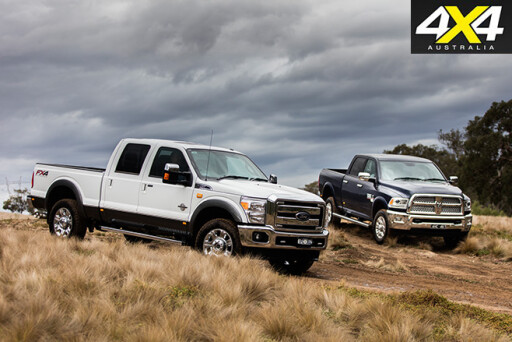 We’ve lined up a truck from each of the Big Three – from three different importer/distributors – to get a feel for how well they work on Australian roads. The Ford F-250 Lariat comes to us from Harrison F-Trucks; the GMC Denali from Performax; and the RAM Laramie 2500 from American Special Vehicles. All these suppliers have full-volume Australian compliance to sell these trucks. We spent two days with them on the tracks and roads of rural Victoria, and also lived with them for a week in town.
We’ve lined up a truck from each of the Big Three – from three different importer/distributors – to get a feel for how well they work on Australian roads. The Ford F-250 Lariat comes to us from Harrison F-Trucks; the GMC Denali from Performax; and the RAM Laramie 2500 from American Special Vehicles. All these suppliers have full-volume Australian compliance to sell these trucks. We spent two days with them on the tracks and roads of rural Victoria, and also lived with them for a week in town.
FORD F-250 LARIAT
IN Australia, Toyota’s HiLux occasionally tops the monthly new-car sales chart, yet in the USA, Ford’s F-Series trucks have been the best-selling vehicle for decades. Part of that comes from the huge range of F-Series, starting with the F-150 and growing through the F-250, F-350, F-450, F-550 and monstrous F-650 rigs. But we’re concentrating on the popular F-250 Super Duty model that’s sold in Australia via several outlets – this Lariat-spec 2015 Effie came from Harrisons in Melton, where it’s a $152,000 offering.
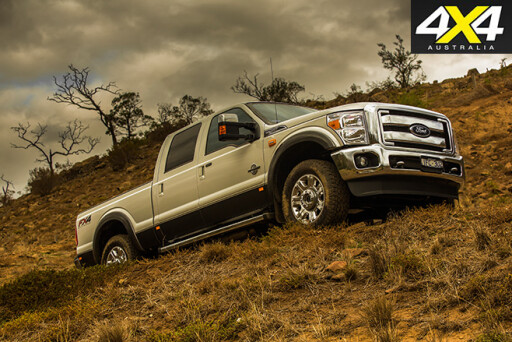 DRIVELINE & CAPACITIES
DRIVELINE & CAPACITIES
YOU’LL generally find all the Super Duty Effies are powered by the Powerstroke 6.7-litre turbo-diesel V8 engine in Australia. They come with a petrol V8 in the US, but there’s no call for that here. The Powerstroke 6.7 makes a plate-shifting 1166Nm from around 1600rpm, which is enough to haul a 7.6-tonne trailer or a 1900kg payload, although these figures are generally down-rated for Australia so that Aussies can drive them with a regular driver’s licence. Check with your importer/dealer for specifics.
The V8 engine is backed by a six-speed automatic transmission and part-time 4x4, while the F-250 is the only vehicle on this test to be fitted with a selectable rear differential lock (RDL). Electronic Traction Control (ETC) is standard.
CHASSIS & HANDLING
THE Ford F-250 Super Duty rides on a heavy-duty ladder chassis with live axles front and rear. The front end sits on coil springs, while the rear is on traditional leaves. These trucks each use old-style steering boxes that have either been relocated to the right-hand side of the chassis or, in some cases, remanufactured in a mirror image of the OE steering box.
The steering in the Harrison F-250 feels very light at all speeds, which makes it nice and easy to park, but on the highway the front end is very reactive to bumps, resulting in the driver needing to make constant corrections. It otherwise offers a relaxed highway gait as the big engine lopes along at low revs, while it’s relatively easy to punt swiftly in the bends. None of these trucks are sports cars, but they aren’t as monstrous as one might expect.
OFF-ROAD
OFF-ROAD testing was done at the Melbourne 4x4 Training and Proving Ground, where we chose a long, steep and rutted climb to evaluate the tractive abilities of the trucks. It’s a hill we’ve seen stop many 4x4s when they hit the deeper holes near the top.
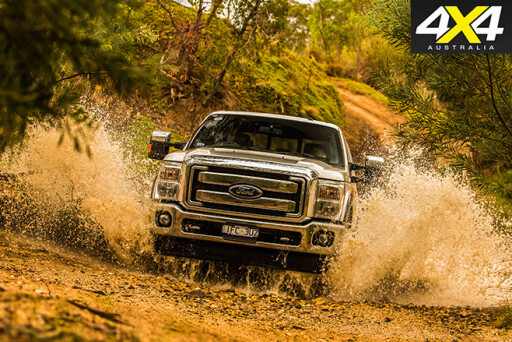 With the rear diff lock engaged, the F-250 made the climb with relatively little scrambling or loss of traction. We put this down to the longer wheelbase of these trucks over more conventional 4x4s, and where it placed the tyres on the track. On the descent it delivered reasonable engine braking, while Hill Decent Control worked well. Even without the RDL engaged, the F-250 crawled its way up with ease, seemingly flexing more than the other trucks.
With the rear diff lock engaged, the F-250 made the climb with relatively little scrambling or loss of traction. We put this down to the longer wheelbase of these trucks over more conventional 4x4s, and where it placed the tyres on the track. On the descent it delivered reasonable engine braking, while Hill Decent Control worked well. Even without the RDL engaged, the F-250 crawled its way up with ease, seemingly flexing more than the other trucks.
TOWING
WITH payloads that barely amount to that of the average one-tonner in Australia, you may be forgiven for thinking these big trucks are a bit ‘style-over-substance’, but towing is what they’re all about. All three are torque monsters with big-displacement engines, so we decided to hitch the best part of three tonnes to the back of them and see how they handled a decent load.
Sure, we’d like to have hitched something heavier behind them, but all three were only equipped with 50mm tow balls and standard hitches – which only allow a load of up to 3.5 tonnes, after which we’d need a 70mm ball up to 4.5 tonnes. Anything above that needs a Pintle hitch or fifth wheel set-up.
The Ford has the most torque and highest towing capacity, at 1166Nm and 7500kg respectively, so it was a front runner to be the best tow tug. While there’s no doubt the drivetrain hauled the load the easiest, the big F-truck didn’t feel so settled on the open road. There was a tendency toward bump-steer that kept us busy on the wheel during the test loop. With a load on board, the rear end of the two-fiddy felt planted and solid, but the front end let it down. Tow mode on the SelectShift transmission made the most of all the horses thundering into it, and downshifts were superb, but we were expecting better road manners when hauling.
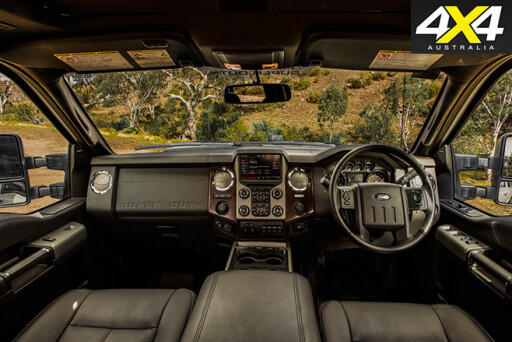 CABIN AND ACCOMMODATION
CABIN AND ACCOMMODATION
THIS is one of the most accommodating cabins on the market, with acres of space in the front and back seats; cushy leather seats; familiar Ford Sync A/V system; extra switches in-dash for accessories; and bucketloads of storage options. It’s got the lot. The sat-nav wasn’t operating, but the guys at Harrisons tell us they’ve sorted that and it can now install local maps.
The cabin in the Effie is so wide my elbow didn’t reach the windowsill while driving, and it’s the only one in this trio like that. The exterior mirrors are huge and power-adjustable, and slide out (motorised) for towing visibility. The rear seat backrest is still a bit too upright, but it’s more comfortable than any Asian ute.
PRACTICALITIES
THE Yanks love big and bold towing hooks, and the F-250 has a pair of fat chrome ones up front – there’s nothing at the back of the truck, except for the receiver for the tow hitch. The Lariat’s chrome wheels are wrapped in 275/65R20 tyres, so don’t expect to find a replacement at your average outback service station. That said, there are plenty of options available in that size from the US.
Under that massive hood (that’s bonnet to you and me) the V8 engine takes up most of the real estate, with no room for a second battery. The air intake is behind the off-side front headlight, while the air cleaner can be serviced without tools. The F-250 carries 140 litres of diesel in its tank.
Handy inclusions in the tray are a fold-out bed-extender that allows you to drive with the tailgate down and retain goods in the tray, and a clever fold-out step with a lever post to help lard-arses haul themselves up into the back.
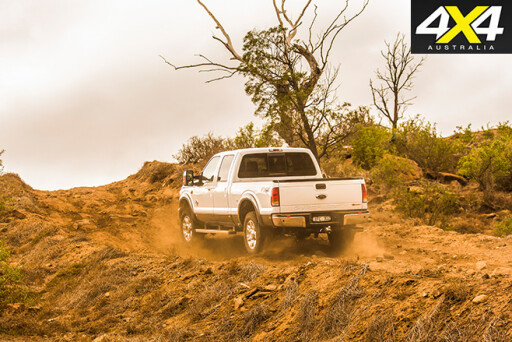 SUMMARY
SUMMARY
THE F-250 Lariat is as big and brash as they come! Its V8 engine might only be a tad bigger than the others here, but it makes the most grunt and you can feel that behind the wheel. It used 21.93L/100km of diesel on test to be the thirstiest of the trucks, but it did more towing than the others as it pulled our car trailer to and from Werribee. The Effie feels the most comfortable off-road, with its supple chassis allowing the wheels and tyres to crawl over rough terrain for a more controlled ride.
That same chassis provided the only blemish on the Effie’s performance, with the aforementioned tendency to bump-steer in the front end, which was evident on rough highways. This does become tiresome on longer drives, and let’s face it: these trucks are made to cover the miles.
The fit-and-finish in the cabin is as good as any Australian-made Ford, and the quality of the left-to-right conversion gave us no reason to think it’s anything but top-notch. Harrison F-Trucks backs its new vehicles up with a full four-year/130,000km warranty, with premium roadside assistance for three years.
SPECS
Engine V8 diesel
Capacity 6.7-litre
Power 328kW @2800rpm
Torque 1166Nm @ 1600rpm
Gearbox 6-speed auto
4X4 System part-time, dual-range
Construction separate chassis; 4-door ute
Front suspension live axle on coil springs
Rear suspension live axle on leaf springs
Tyre spec LT275/65R20
Kerb Mass N/A
Payload 1900kg*
Towing capacity 4500kg*
Seating capacity Five
Fuel tank capacity 140 litres
ADR fuel claim N/A
Test consumption 21.93L/100km
*Subject to state laws and licencing regulations
GMC SIERRA DENALI 2500
GMC is the truck brand for General Motors, and the Sierra is basically a Chevrolet Silverado with a different face. Denali is the upper-spec range, so it adds more bling and safety features, but the chassis and drivelines are the same between the two trucks. Performax, who converted and supplied this truck, told us that a Silverado built to the same spec would sell for around $2K less than the Denali’s $152,000.
 DRIVELINE & CAPACITIES
DRIVELINE & CAPACITIES
THE GMC Denali and the Silverado both use GM’s Duramax 6.6-litre turbo-diesel V8 mill. Forget that Holden borrows the Duramax brand for its small Italian-made diesel engine – this V8 is the real Duramax deal. 1037Nm and nearly 300kW might be a tad short of the Ford’s figures, but the GMC wants for nothing. It will still haul an 8.0-tonne trailer or carry a 1.6-tonne payload, but, like the Ford, these are down-rated to a 4.5-tonne GVM to allow Aussie drivers to operate it on a regular licence.
The Duramax is backed by a six-speed auto transmission from heavy-duty driveline experts Allison. It has a towing mode, as well as an exhaust brake, to help slow the beast when towing down steep grades. It also makes you sound like a real truck driver! The rear axle in the Denali has an auto-locking differential from Eaton, while ETC is part of the chassis electrics package.
CHASSIS & HANDLING
WHILE these three heavy-duty pick-ups may appear to be built to the same formula, they each feature different underpinnings. The GMC rides on a separate ladder chassis and, like the F-250, features a live rear axle on an HD leaf spring pack. However, it differentiates itself from the other two by using an independent front suspension design with torsion bar suspension. This is more like the one-tonne utes we’re familiar with here, although most of those have now ditched torsion bars in favour of coil springs.
The IFS gives the GMC a more controlled and less truck-like ride and demeanour on-road, with less kick-back through the steering and a sharper feel. For anyone not accustomed to driving large, live-axled trucks, the IFS-equipped GM products will be the easiest to adapt to.
OFF-ROAD
WITH IFS, we expected the Denali to struggle on our off-road climb, but it didn’t disappoint. While not as supple as the Ford, the Denali climbed with confidence, its locking rear end pushing the truck onward and up. The rear axle also has plenty of articulation, which helped its cause, keeping those big 20-inch tyres driving. This particular vehicle is privately owned and the owner has fitted Goodyear All-Terrain tyres and Rancho shock absorbers, which would have helped it. The pair of LED light bars up front are also owner-fitted.
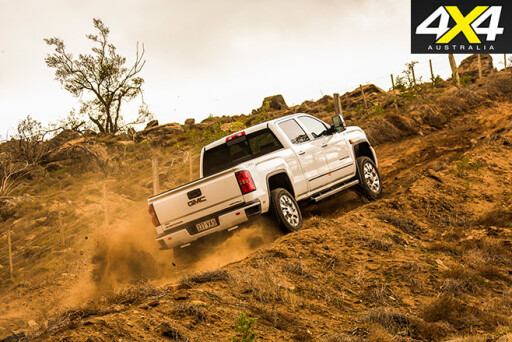 TOWING
TOWING
THE Duramax V8 develops a deep-throated snarl under load, and it hauled our car and trailer up the Brisbane Ranges with aplomb. The independent front end of the GMC gave it the best handling under load, and the six-cog Allison tranny joined in to help the Denali haul confidently and comfortably. The tow setting on the transmission, along with the exhaust brake, made the descent a cinch.
CABIN AND ACCOMMODATION
THERE’S no denying the size of the cabins in these trucks, and the GMC is large and luxurious. Heated and cooled power-adjustable seats, plenty of storage options, heated steering wheel and dual-zone climate control – there’s nothing missing from the Sierra Denali.
Something we don’t see in smaller utes are adjustable pedals, and all three of these trucks have electric adjustment to bring the pedals closer to, or further from, the driver’s seat.
This Denali is fitted with the optional Driver Safety Alert Package, which is a no-cost option from Performax. It adds lane departure warning and forward collision warning, and the warnings are accompanied by a vibration in the seat base – left cheek if you veer left, right cheek for the right and a warning if you’re approaching an object in front of you. This is the only truck here with that sort of safety technology.
The Denali uses GM’s OnStar system, and Australian maps can be loaded onto it. It also uses Apple CarPlay to sync with your Apple device; the sound pumps out through a Bose speaker system. Soft touchpoints throughout the cabin give the Denali a premium feel.
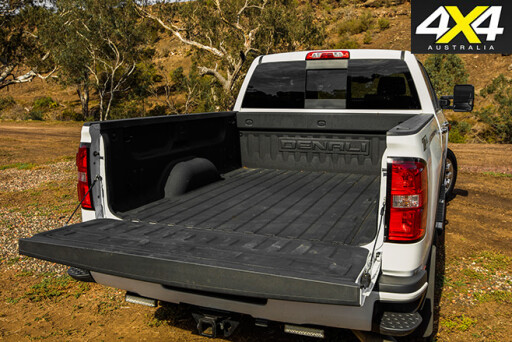 PRACTICALITIES
PRACTICALITIES
265/60R20 Goodyear Wranglers wrap around big chrome wheels, so it’s not a common tyre size here in Australia. The engine breathes through the offside front ’guard, but the air-cleaner requires a screwdriver to gain access. The owner of this GMC has fitted an aftermarket dual-battery system, with the auxiliary battery mounted in the engine bay.
There are two heavy-duty tow points in the front bumper and a received hitch can be used at the back. The tray has a spray-on bed liner, with four tie-down hooks for securing loads. The step indents in the sides of the rear bumper – to make stepping into the tray easier – are a clever touch. However, they’re not as cool or complex as the Ford’s fold-down step.
SUMMARY
THE GMC Denali is the most luxurious and user-friendly of the trucks in this trio. The IFS makes it more manageable on the road, particularly for drivers not used to live-axle trucks, while the fit-and-finish and equipment level inside give it a premium feel. It surprised us with its ability on the off-road hill climb, while out on the road its Allison 1000 transmission felt the best of the group – both when towing and unladen. Consuming 17.18L/100km during our test, the GMC was the most frugal of the trio.
Performax backs its vehicles with a four-year/120,000km factory-backed warranty, which includes 24-hour roadside assistance on new vehicles.
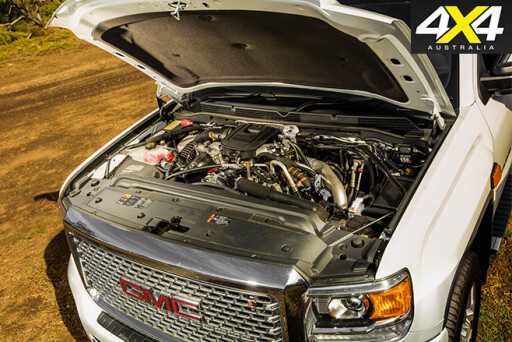 SPECS
SPECS
Engine V8 diesel
Capacity 6.6-litre
Power 298kW
Torque 1037Nm @ 1600rpm
Gearbox 6-speed auto
4X4 System part-time, dual-range
Construction separate chassis; 4-door ute
Front suspension IFS with torsion bars
Rear suspension live axle on leaf springs
Tyre spec LT265/60R20
Kerb Mass N/A
Payload 1145kg
Towing capacity 4500kg*
Seating capacity Five
Fuel tank capacity 136 litres
ADR fuel claim N/A
Test consumption 17.18L/100km
*Subject to state laws and licencing regulations
RAM LARAMIE 2500
RAM broke away from the Dodge brand some years ago to become its own entity, while the trucks are still built by Chrysler in the USA. The Dodge RAM nameplate goes back for decades and is a staple of the American truck market.
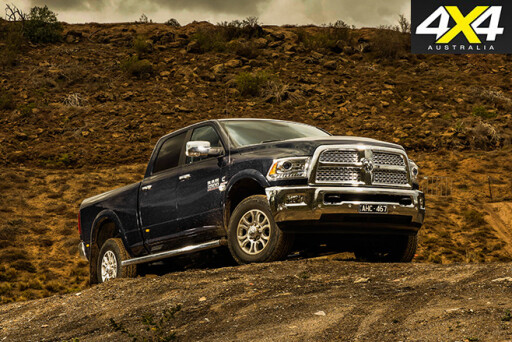 American Special Vehicles (ASV) is a division of Ateco who, among other brands, also bring Warn winches to Australia. The left-to-right conversion and engineering is carried out by the Walkinshaw Group, which includes Holden Special Vehicles. ASV is currently selling only the high-specification RAM Laramie crew-cab 4x4 model in Australia, in 2500 or heavier-duty 3500 guise.
American Special Vehicles (ASV) is a division of Ateco who, among other brands, also bring Warn winches to Australia. The left-to-right conversion and engineering is carried out by the Walkinshaw Group, which includes Holden Special Vehicles. ASV is currently selling only the high-specification RAM Laramie crew-cab 4x4 model in Australia, in 2500 or heavier-duty 3500 guise.
We’ve got the 2500 here in line with the others’ offerings, and it’s the lowest priced truck in the trio at $139,500.
DRIVELINE & CAPACITIES
THE RAM might be the only non-V8 engine here but its in-line six-cylinder donk gives nothing away in capacity, coming in at a massive 6.7 litres. It’s the mid-runner for output, pushing out 1084Nm from the Cummins-branded engine. The transmission is a six-speed auto, while 4x4 is part time with shift-on-the-fly and low range – just like the other two.
The RAM has Tru-Lok diffs front and rear, which are an auto-locking design. ASV’s Australian models are already de-rated from the US specs to a maximum 4500kg GVM, to accommodate local licences. That means a 913kg payload and 3500kg towing on a 50mm ball (4500kg on 70mm ball, or 6989kg on a Pintle).
CHASSIS & HANDLING
THE RAM 2500 bolts to a ladder-frame chassis like the other two trucks – it has live axles front and rear like the Ford, but unlike the truck-like leaf springs under the first two, the RAM rides on coils at each corner. We expected that using coils might make the RAM softer and more compliant in its ride, but the opposite proved the case.
The very stiff RAM suspension provided a sometimes jittery ride, and handling was very flat. You can feel it has been sprung to carry a load, which was reflected in its towing performance.
 In its left-to-right steering conversion, ASV has taken the steering box from the left and moved it to the right, but placed it on the outside of the chassis rail just like another Chrysler product – the Jeep Wrangler.
In its left-to-right steering conversion, ASV has taken the steering box from the left and moved it to the right, but placed it on the outside of the chassis rail just like another Chrysler product – the Jeep Wrangler.
OFF-ROAD
THE stiffness of the RAM’s suspension was felt on the off-road track, where it bucked like a bronco over the bumps and bounced off-line. It was never challenged for grip, but it was bouncing over rocks rather than crawling over them, which made the job a lot harder than it needed to be. The tyres on all the trucks were left at road pressures throughout the test; dropping them might have helped the RAM’s performance.
TOWING
THE RAM was the most surprising performer on the towing hill climb. It was the only truck equipped with a multi-link coil-sprung rear end, however it was the most solid rear end – its bum barely moved when the trailer was hitched to it. A towing capacity of a little less than seven tonnes is still nothing to be sneezed at!
The six-cylinder Cummins lets out a truck-like growl under load and has an impressive spread of power and torque. The engine brake did an awesome job of holding back the loaded truck on the descent, and it had the tranny down-changing early to make the most of the Cummins’ compression braking power. It sounded awesome as well!
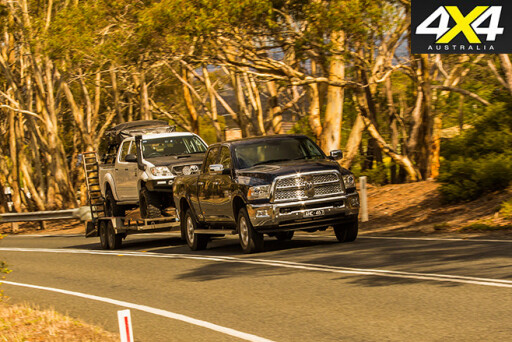 CABIN AND ACCOMMODATION
CABIN AND ACCOMMODATION
ANYONE who has driven a Jeep Grand Cherokee will feel at home in the RAM. The centre stack, Uconnect system, steering wheel and gauge cluster are all very similar (if not the same parts), there’s just a lot more real estate around them in the RAM. In that regard it was pretty easy for us to get acquainted with.
Like the other trucks here, the RAM Laramie has all the luxury mod-cons: climate control; heated and cooled seats; sat-nav with local maps; heated steering wheel; power pedal adjustment; and primo audio. None of these trucks are lacking in the features department! Considering they are all so highly specced, it was surprising that the RAM is the only one with keyless entry and start.
The RAM’s also the only one with the ability to carry six passengers, as the console folds up to reveal a centre seat in the front. The console bins in all of them could house a small family, though!
One annoying thing is that the park brake is a foot pedal on the right-side kick panel in the footwell – and when you stop the car you generally have your right foot on the foot brake, so it requires a change of habit to get used to.
PRACTICALITIES
THE RAM has the most practical wheel and tyre package with its LT265/70R18 Michelins. They mightn’t look as flash as the big chrome 20s, but they’re more resistant to damage than the low-profile jobbies.
Again, there are two big tow-loops up front and a receiver hitch at the back. The air intake is through the front ’guard and requires a screwdriver to open the air box. There are two batteries in the engine bay.
The huge tray has a spray-on protective lining and four tie-down hooks. A nifty trick here is that up near the cargo area light, a camera displays the cargo bed on the Uconnect screen and lets you know if the load is moving around or your dog has jumped ship.
The RAM has a 117-litre diesel tank and, like all of these trucks, the engine runs SCR/DEF to cut emissions.
 SUMMARY
SUMMARY
AMONG our trio of trucks the RAM looked the smallest, but that was just an illusion created by the dark colour and the styling of the front, which isn’t as brash as the Ford’s or GMC’s. It’s still a big truck, and with the bench front seat has the highest seating capacity here.
It’s also more than $10K cheaper than the other two rigs, which can buy you a lot of accessories. Some upgraded suspension with softer springs might be the go if you’re not going to haul heavy loads all the time.
The RAM holds the middle ground in performance and in the way it towed, but the six-cylinder Cummins engine proved relatively thirsty at 21.35L/100km.
ASV backs its RAMs with a three-year/100,00km warranty, with roadside assistance.
SPECS
Engine I6 diesel
Capacity 6.7-litre
Power 276kW @ 2800rpm
Torque 1084Nm @ 1600rpm
Gearbox 6-speed auto
4X4 System part-time, dual-range
Construction separate chassis; 4-door ute
Front suspension Live axle on coil springs
Rear suspension Live axle on coil springs
Tyre spec LT265/70R18
Kerb Mass 3577kg
Payload 913kg
Towing capacity 4500kg*
Seating capacity Six
Fuel tank capacity 117 litres
ADR fuel claim N/A
Test consumption 21.35L/100km
*Subject to state laws and licencing regulations
THE BEST PICK-UP
IN THIS test we’re not only comparing three auto manufacturers, but we’re testing three different left-to-right steering conversions and adaptations to Australian specifications. All the conversions are top-notch, using new one-piece RHD dashboards and specifically manufactured steering components.
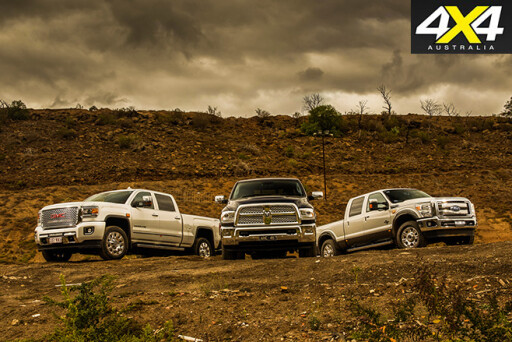 However, there are still signs of the conversions if you look for them. Things like the placement of the park brake pedal, or the switches for the seat heaters that have the passenger’s seats on the right – little things that don’t blemish the excellent work these companies are doing.
However, there are still signs of the conversions if you look for them. Things like the placement of the park brake pedal, or the switches for the seat heaters that have the passenger’s seats on the right – little things that don’t blemish the excellent work these companies are doing.
Each of these three trucks have their good and not-so-good points, so, as is often the case, it will come down to what vehicle feels right, and what deal works best, for you. However, as these are specialised vehicles, don’t expect to find the same kind of discounting you would with mainstream cars.
The F-250 has the best-performing engine and felt the best off-road. It also made easy work of the towing, but it was let down by annoying bump-steer.
The Cummins-powered RAM is the lowest-priced truck here and gave nothing away to the V8 in terms of performance or towing. Its conversion feels the most OE of the group, although the placement of that park brake is frustrating.
The GMC is the best all-rounder and has the most up-spec equipment level in its spacious cabin. The IFS front end makes it more relaxed to drive on-road and it didn’t hold the Denali back off-road.
Its horses for courses, and these trucks all delivered plenty of horses from under their big hoods. So it’s best to corral each of them and find the right one for you and your budget.

COMMENTS